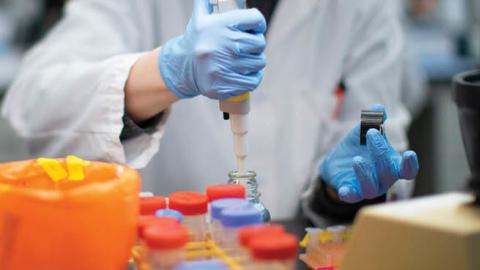The novel corona virus — as did the Japanese strike at Pearl Harbor— constitutes a sudden attack on the United States with profound implications for the security and well-being of every American.
The dark days following Pearl Harbor found us scrambling to stop the German and Japanese forces. Today we are working to “flatten the curve” before the virus overwhelms our medical system. Once we stabilized the situation in 1942, we could focus on winning the war and securing the peace.
This meant making sure we won what appeared to be a race to develop the war’s super weapon—the atomic bomb. The Manhattan Project found us mobilizing the public and private sectors, including the country’s best scientific minds, to develop the bomb before our enemies did. More broadly, Washington established the War Production Board (WPB) to oversee and coordinate the “arsenal of democracy.”
As in the days following Pearl Harbor, the COVID-19 virus attack finds us racing against time to bring the threat under control before it inflicts catastrophic human suffering and economic damage. Now “war” production has three main goals. First, we must mass produce tests that accurately identify those infected by the virus, so they can be quarantined to minimize its spread and obtain treatment. This will slow the virus’ spread, “flattening the curve” and keeping our health care system from becoming overwhelmed.
Second, since we lagged in developing tests for the virus, many who have taken ill have not been identified. There are probably many who fell ill but did not seek treatment, or whose symptoms were mild. We need a test to identify those who have recovered from the virus so they can be certified to return to work and “restart” the economy.
Third, we need a vaccine. Just as the Manhattan Project involved scientists supported by the industrial base pursuing multiple paths toward an atomic bomb, today we find multiple efforts aimed at producing a vaccine. Getting to a vaccine in 12-18 months, as currently estimated, is too long. We need to compress the process.
This requires a coordinating body. We need a modern-day WPB—call it the Antivirus Coordination Board—to set priorities and support the private sector’s research and production, while sharing information and providing prompt support when needed. A current small-scale example is the COVID-19 High Performance Computing Consortium of private groups and government, which is coordinating the use of advanced computers at NASA, the National Security Agency, and our nuclear weapons laboratories—Los Alamos and Lawrence Livermore—all linked to the computational resources of Google, IBM and Microsoft. High-speed computational power is needed to support experiments in molecular modeling, epidemiology and bioinformatics, reducing the time it takes to process experimental data and accelerating the discovery process. Success here will likely arrive sooner if we can pool the nation’s advanced artificial intelligence resources with an eye to identifying insights from research that humans might miss.
Since efforts similar to ours are occurring in other countries as well, the ACB will need a bioinformatics team comprising members of the private sector, academia and government to engage with other responsible countries to move forward on a common front to defeat the virus, while archiving and sharing the knowledge gained to prevent future microbial outbreaks.
While the race to identify these tests and a vaccine is proceeding, we must create the infrastructure required to mass produce them as they are identified. As Henry Ford stepped forward in World War II to support bomber production, today Bill Gates, through his foundation, is funding factories for vaccine production. More of America’s wealthiest need to follow his example, and the ACB needs to coordinate such efforts to minimize duplication of effort and production bottlenecks, cutting bureaucratic red tape when necessary to get results.
Since test and vaccine production will not instantaneously meet the need, the ACB will need to identify those groups at greatest risk so they can receive priority treatment.
There is important work to be done by our traditional security establishment that concerns “winning the peace” following the pandemic. Victory in World War II did not end the competition between states for power and influence. During the war Britain, Soviet Russia and the United States found themselves momentarily “in it together” to defeat the Axis powers. Yet the Soviets viewed the alliance as a marriage of convenience, denying that their pact with Hitler aided his aggression, aggressively infiltrating the United States with spies to steal technology and maneuvering to dominate a war-ravaged Europe once the immediate danger had passed.
In the current crisis, China’s aggression in the social dimension of warfare is aimed at suppressing internal doubts over its culpability for the current crisis while also undermining confidence in free countries’ democratic institutions. The Chinese covered up the virus’ initial outbreak. Then they denied the dangers it posed to global health. Now that the virus has spread, they are trying to shift blame to others, while taking credit for bringing the virus under control in China under cover of a selective information blockade.
Following the defeat of the Axis powers, Soviet Russia began imposing control over Eastern Europe and trying to destabilize war-torn Western Europe. George Marshall called their system “antagonistic to all we find moral and desirable.” Our response was the Marshall Plan. The Truman administration worked with Congress to establish the Economic Cooperation Administration (ECA). It provided guidance and support to the country’s business sector as America undertook a massive effort to aid in Western Europe’s economic recovery.
While the immediate stakes may not be as high today as they were in the 1940s, today we find ourselves not only in a struggle against an enemy at the gates—the virus—but with a rival who seeks to exploit any opportunity to advance its revisionist agenda. Our best defense against Beijing’s malign intentions is to create a latter-day “arsenal of democracy” tasked with producing the means by which to defeat the virus, Mass production of tests and vaccines will speed our recovery.
This will then allow us to undertake a current-day Marshall Plan, providing testing and vaccines to nations in need. As with the ECA, an oversight and coordination body will be needed to bring together the U.S. business sector, the relevant sectors of the U.S. government, and foreign entities. As an earlier generation of Americans found through the Marshall Plan, helping others can be the best way to help ourselves, in this case by assisting other nations get the virus under control.
Today the great challenges of the 1940s are distant echoes of those we confront today. If we are at war, it is a very different kind of war than that waged by the “Greatest Generation.” But there are important similarities, which offer insights regarding our current situation.
President Trump, with justification, has declared himself a wartime president. If he is to meet today’s wartime challenges, he must move quickly with actions to match his rhetoric.
Read in Breaking Defense

















